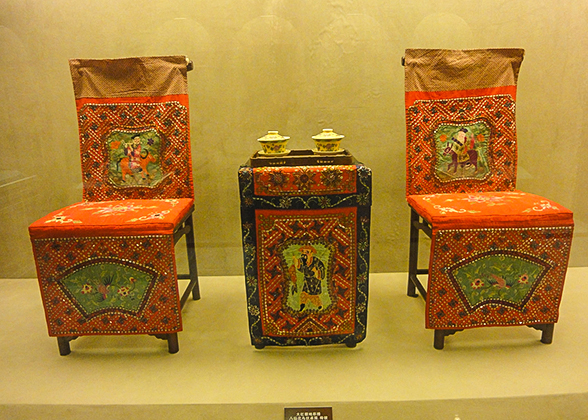Suzhou Silk Museum
Suzhou Silk Museum is located in Suzhou City which is well known as the 'Paradise on Earth'. Suzhou, in Jiangsu Province, is not only a famous cultural city and a city of gardens, but also the silk capital of China. During the Tang (618-907) and Song (960-1279) dynasties, it was the silk producing center; in the Ming (1368-1644) and Qing (1644-1911) dynasties most of the high-grade silk produced for the royal families was made by silk weavers here.
The entire museum design is dignified and elegant - yet unconventional - combining a sense of ancient civilization with modern style. It is divided into eight parts: the Introductory Hall, the Ancient Exhibit Hall, the Silkworm-Rearing Room, the Silk Weaving Workshop, the Vegetable Garden, the Central Hall, the Neoteric (1840-1919) Exhibit Hall, and the Modern (1919-1949) Exhibit Hall. There are also retail stores for purchasing silk.
 |
| Silk Dragon Embroidery |
The dominant color of the Silk Museum is white, which represents the purity of silk. Strolling through the gate here, you can see a long and elegant white wall running from south to north, crossing an east-west passage symbolizing the Silk Road. The wall curves at the entrance, symbolizing the softness and elegance of the silk. In front of the wall, there are three tall sculptures made of white marble. The first shows a girl picking mulberry leaves (the silkworm's favorite food); the second, a girl washing the raw silk fabric; the third, a girl weaving. The three sculptures give the whole museum a dynamic beauty, imparting a sense of freshness to the construction and decoration style. A tower-shaped roof on the main building of the museum reminds people of the exotic flavor of the Silk Road.
|
|
|
|
Everyone knows that silk, silkworms, and the mulberry bush are closely related. The Silkworm-Rearing Room replicates conditions during the late Qing dynasty. You will enjoy the relaxing feeling of a simpler time. Here you will see thousands of silkworms all eating their favorite food, mulberry leaves. It is a memorable experience that will stay in your mind forever.
 |
| The Old Loom |
Passing through a gate pass symbolizing Jiayuguan Pass on the ancient Silk Road, you enter the Central Hall. A passage paved by granite extends from the Introductory Hall and connects a stone bridge in the west end of the Central Hall, leading to Yuyangguan Pass, the west gate of the Silk Museum. On one side of the stone bridge hangs a model of the ship once served for Zheng He’s voyage to the west. On the other side, a model of the Big Wild Goose Pagoda in Xi'an, an inevitable pass on the Silk Road, stands in water. The two models respectively represent the overland and maritime Silk Road routes, which combine with each other to unveil ancient civilization to the world.
In the Neoteric (1840-1919) and Modern (1919-1949) Exhibit Halls, you can get an overview of the exquisite craftsmanship of Suzhou silk. You'll see a variety of exhibits featuring silk clothes, silk products that have received international awards, skillful craftsmen, famous people in the silk field, the development of the local silk industry, and the history of the Silk Road.
In the Suzhou Silk Museum you will also find a 'Ming and Qing Street' lined with replicas of time-honored silk stores. Its traditional Suzhou flavor will make a deep and unforgettable impression on you. You can't visit these stores without wanting to buy something!
Whenever you come to Suzhou - the Paradise on Earth - please don't miss the Suzhou Silk Museum. It will not disappoint you!
Transportation
Suzhou Bus Search
Admission Fee & Opening Hours
| Admission Fee | Free of charge |
| Opening Hours | 9:00 - 17:00 Closed on Monday (except public holidays) * Note: Visitors are not allowed to enter after 16:00. |



